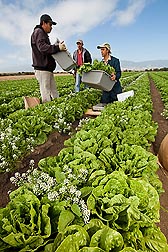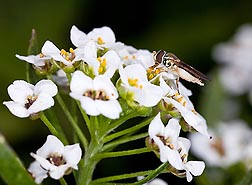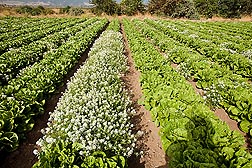Flower Power Protects Organic Lettuce Fields
|
|
In the language of flowers, sweet alyssum means “worth beyond beauty.” Now findings by Agricultural Research Service horticulturist Eric Brennan are highlighting some cost-effective measures to help the tiny white blossoms live up to their reputation.
“Organic lettuce growers like to use alyssum in their production because it is such an effective way to control aphids,” Brennan says. “If you drive by a field in central California that has a lot of alyssum, it’s almost guaranteed to be an organic lettuce field.”
Lettuce growers in California’s central coast plant alyssum to attract adult hoverflies that feed on the flower’s pollen and nectar. After eggs laid by the well-fed females hatch, the voracious larvae prey on currant-lettuce aphids—important primary insect pests of lettuce in the region. The aphids are particularly difficult to control because they colonize the interior leaves of the lettuce plant.
Alyssum is so effective at helping to control aphid populations that it can be planted on up to 10 percent of the land used to grow organic lettuce. But agricultural rent in central California can be costly, so growers need to devote as much land as possible to cash crop production.
Brennan, who works at the ARS U.S. Agricultural Research Station in Salinas, California, wanted to figure out the most cost-effective alyssum planting patterns in lettuce fields to help organic producers maximize their profits. At a working research farm in Salinas that is certified for commercial organic production, he established experimental beds with several different planting combinations of alyssum and romaine lettuce.
Blossoms With Benefits
In five of these combinations, 2 percent to 8 percent of the lettuce plants were replaced by alyssum plants. These were called “replacement” treatments, and each replacement plot was planted at a rate equivalent to 26,440 lettuce plants per acre. In two of the other combinations, alyssum was planted in addition to the full complement of lettuce. One of these beds was planted at a rate equivalent to 27,087 lettuce plants per acre and the other at a rate equivalent to 28,598 lettuce plants per acre. These two treatments were called “additive” treatments. Brennan also varied the distribution of the flowers in the fields by either planting the alyssum in strips or interspersing it with the lettuce plants.
|
|
For two growing seasons, Brennan evaluated how alyssum biomass and flower production varied with alyssum planting density and how competition between lettuce and alyssum affected the biomass of both plants.
The scientist observed that alyssum in the additive beds produced more blossoms per gram of alyssum dry matter, possibly because the alyssum plants and lettuce plants were competing more directly for nutrients needed to support biomass production. This combination increased alyssum’s value as an insectary plant—a flowering plant cultivated in crop fields because it attracts insect predators to feed on pests.
Brennan also noticed that in the additive treatments, alyssum and lettuce canopies began to overlap around 22 days after they had been transplanted to the field, while in the replacement beds, the canopies did not start to overlap until 32 days after transplanting. This observation provided additional evidence that competition between alyssum and lettuce in the additive treatments began earlier in the season and was more intense than competition in the replacement treatments.
Brennan thinks these findings will be useful in determining the best way to intercrop alyssum in lettuce production systems to effectively control aphids; maximize lettuce yield and profitability; and minimize the costs and complications that come with transplanting, weed management, harvesting, marketing, and postharvest tillage.
His field research indicates that additive treatments may be the most efficient intercropping approach for producing romaine lettuce hearts, where smaller lettuce plants are desired. This is because the number of lettuce plants was not reduced in additive treatments, and alyssum transplants in the additive treatments were able to produce 78 percent as many open alyssum flowers as the replacement treatments. Although lettuce from replacement beds produced more biomass, Brennan believes that this increase might not be relevant at a commercial scale once the lettuce is harvested, trimmed, and packed for market.
|
|
A Scattered Approach
Brennan has also concluded that an alternative to intercropping lettuce with strips of alyssum in specific rows would be to randomly intersperse alyssum plants throughout all lettuce rows, an approach that is already being used by some lettuce producers. Dispersing the alyssum throughout the field could minimize competition between lettuce and alyssum. It may also encourage adult hoverflies to forage for pollen and nectar more evenly throughout the field.
This alternative would also eliminate concentrated strips of alyssum that are difficult to hand weed—an important consideration in organic cropping because hand weeding is expensive and weeds that survive can produce seed that infest future crops. Scattering alyssum throughout a field could also minimize postharvest tillage requirements, because alyssum shoot residue can be difficult to incorporate into the soil, especially when it is concentrated in strips.
“This was a fun and colorful trial,” concludes Brennan, who published results from his work in Biological Control. “I’m getting international requests for the paper, and now I’m working with a large-scale organic lettuce producer on different ways of planting alyssum and lettuce.”—By Ann Perry, Agricultural Research Service Information Staff.
This research is part of Agricultural System Competitiveness and Sustainability, an ARS national program (#216) described at www.nps.ars.usda.gov.
Eric Brennan is with the USDA-ARS Agricultural Research Station, 1636 E. Alisal St., Salinas, CA 93905; (831) 755-2822.
"Flower Power Protects Organic Lettuce Fields" was published in the January 2014 issue of Agricultural Research magazine.









